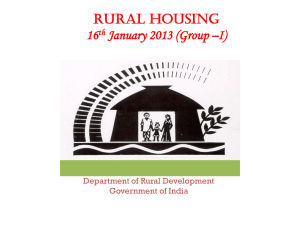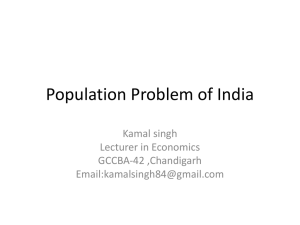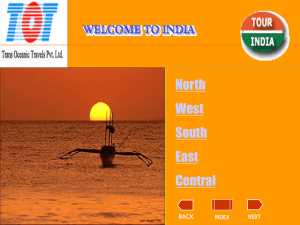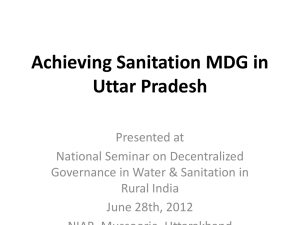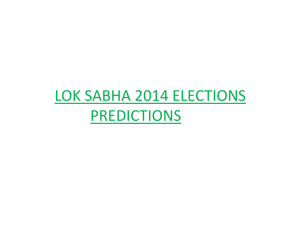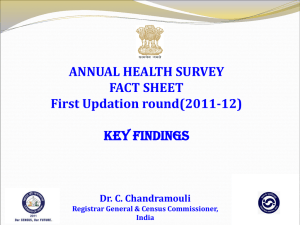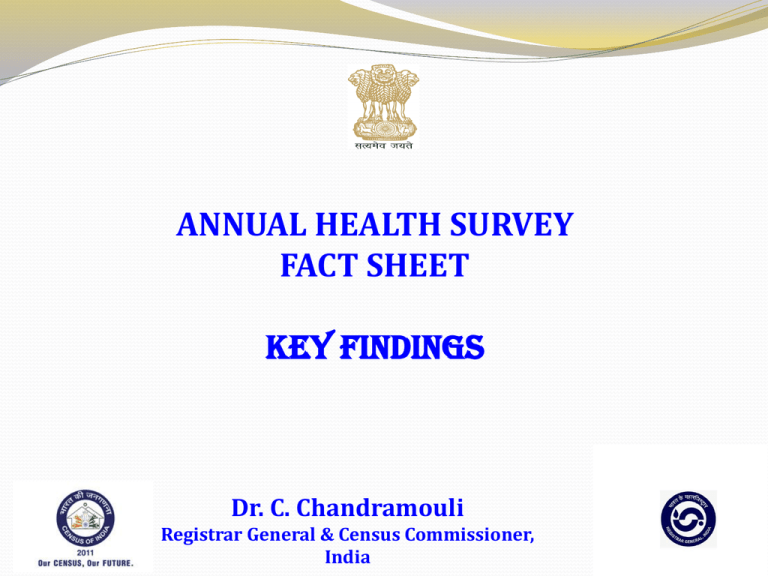
ANNUAL HEALTH SURVEY
FACT SHEET
KEY FINDINGS
Dr. C. Chandramouli
Registrar General & Census Commissioner,
India
“ Reproductive health and rights are integral to
sustainable development and poverty reduction.
Investing in universal access to reproductive health is
crucial investment in healthy societies and a more
sustainable future”.
– Ban Ki-moon, Secretary-General, UN on World
Population Day, 2012
“ Working for the survival and the well being of women and
girls is a human right imperative. And in order to take
advantage of women’s full potential in the development of
their nations, they must be able to plan their lives and
families.”
– Babatunde Osotimehin, Executive Director, UNFPA on World
Population Day, 2012
AHS provides key indicators on Reproductive
and Child Health at District level
in 8 EAG States and
Assam
Vital inputs for evidence based intervention and monitoring
“ There should be an Annual Health Survey of all
districts which could be published/monitored and
compared against benchmarks”
-Dr. Manmohan Singh, Prime Minister of India – In the meeting
of National Commission of Population, 2005
OBJECTIVE OF AHS
AHS yields a comprehensive, representative and
reliable dataset on core vital indicators including
composite ones like IMR, MMR and TFR along with
their co-variates (process and outcome indicators) at
the district level and maps changes therein on an
annual basis.
These benchmarks would help in better and holistic
understanding and timely monitoring of various
determinants on well-being and health of population
particularly Reproductive and Child Health.
Coverage : Annual Health Survey
Uttarakhand
Rajasthan
Uttar Pradesh
Assam
Bihar
Madhya Pradesh
Jharkhand
Chhattisgarh
Odisha
WHY AHS?
o
o
o
o
AHS States constitute:
• 48 percent of country’s Population
• 59 percent of Births
• 70 percent of Infant Deaths
• 75 percent of Under 5 Deaths
• 62 percent of Maternal Deaths
Enable direct monitoring of UN Millennium Development Goals on
Child Mortality and Maternal Health at the district(s) level.
Help in identifying high focus districts meriting special attention in
view of stark inter-district variations in these States.
Provide critical inputs to assess the milestones of various
interventions including NRHM and pave the way for evidence
based planning.
KEY FEATURES
Coverage- All the 284 districts of 8 EAG States and Assam.
Sample
Units- 20,694 statistically selected sample unit (Census
Enumeration Blocks in urban areas and Villages or a part thereof in rural
areas)
Sample Identification Work- to uniquely identify the sample units on
ground, firm up its boundaries, demarcate the localities and prepare a
notional map of the sample unit was done by the staff of ORGI.
Sample Units per district- 73.
Sample Population- About 20.1 million
The Largest Sample Survey in the World
KEY FEATURES
Contd…
Sample Population per district - About 71 thousand.
Sample Households - 4.1 million households.
Sample households per district - About 14.5 thousand.
Conduct of Field Work - hybrid approach wherein fieldwork has
been outsourced and supervision is being done by the ORGI.
Primary Level of Aggregation – District
Periodicity- Annual
Indicators under AHS
• In all, 161 indicators are available from AHS baseline:
Fertility- 13
Sex Ratio- 3
Marriage- 5
Mortality- 7
Mother & Child Care- 63
Ante Natal Care: 11
Post Natal Care: 5
Immunization: 8
Birth Weight: 2
Birth Registration: 2
Awareness in Mothers: 4
Delivery Care: 8
Janani Suraksha Yojana (JSY): 3
Vitamin A & Iron Supplements: 2
Childhood Disease: 6
Breastfeeding & Supplementation: 12
Abortion- 6
Family Planning Practices- 15
Disability- 1
Morbidity- 19
Personal Habits:adults-4 Housing & HH Characteristics- 13
Others- 12
Indicators under AHS
Contd…
Under 1st phase of AHS following 9 indicators have already been
released:
Crude Birth Rate (CBR)
Crude Death Rate (CDR)
Infant Mortality Rate (IMR)
Neo-Natal Mortality Rate (NNMR)
Under Five Mortality Rate (U5MR) Maternal Mortality Ratio (MMR)
Sex Ratio at Birth (SRB)
Sex Ratio (0-4 years) and
Sex Ratio (All ages)
Remaining 152 indicators are being released under present phase of
dissemination.
Five Core Themes Covered
• The presentation focuses on results pertaining to 5 core themes:
Total Fertility Rate
Family Planning: Current Usage & Total Unmet Need
Ante Natal Care
Delivery & Post Natal Care
Immunization and Breast Feeding Practices
Total Fertility Rate (TFR)
• TFR is the average number of children born to a woman during her entire
reproductive span.
Total Fertility Rate
4.0
3.5
Total
Rural
Urban
2.8
3.9
3.7
2.7
3.6
2.5
3.4
3.2
3.5
2.4
2.4
3.1
3.3
3.1
2.3
1.9
3.1
2.7
2.6
1.9
2.4
2.3
2.0
2.4
1.5
2.3
2.0
2.9
2.5
3.9
3.0
1.0
Uttarakhand
Odisha
Assam
Chhattisgarh
Jharkhand
Madhya Pradesh
Rajasthan
Uttar Pradesh
Bihar
• Uttarakhand & Odisha and UP & Bihar reflects the two extremes.
• Significant Rural-Urban variation across all 9 AHS States, the max. in Uttar Pradesh.
Total Fertility Rate (TFR)
State
Assam
Bihar
Jharkhand
Madhya Pradesh
Chhattisgarh
Odisha
Rajasthan
Uttar Pradesh
Uttarakhand
State value
2.6
3.7
3.1
3.1
2.9
2.3
3.2
3.6
2.3
Contd…
Total Fertility Rate (TFR)
Minimum
Maximum
Kamrup (2)
Hailakandi (4.2)
Patna (2.8)
Sheohar (4.7)
Purbi Singhbhum (2.4)
Lohardagga (4)
Indore (2.2)
Shivpuri (4.5)
Koriya (2.4)
Kawardha (3.7)
Jharsuguda (2)
Boudh (3.7)
Kota (2.6)
Barmer (4.7)
Kanpur Nagar (2.3)
Shrawasti (5.9)
Pithoragarh (1.7)
Haridwar (3.1)
Range
2.2
1.9
1.6
2.3
1.3
1.7
2.1
3.6
1.4
Within a State, the minimum variability of 1.3 reported in Chhattisgarh and the
maximum, 3.6 in Uttar Pradesh.
Across 284 districts in 9 AHS States, it ranges from 1.7 in Pitthoragarh
(Uttarakhand) to 5.9 in Shrawasti (UP)- a variability of more than 4 children.
Total Fertility Rate (TFR) Contd…
Frequency distribution of districts by level of Total Fertility Rate
State
Assam
Bihar
Chhattisgarh
Jharkhand
Madhya Pradesh
Odisha
Rajasthan
Uttar Pradesh
Uttarakhand
All States
0-2.1
2.2-3.0
3.1-4.0
4.1 & above
Total Districts
3
0
0
0
0
10
0
0
7
20
16
1
12
8
15
18
16
9
5
100
3
26
4
10
25
2
13
48
1
132
1
10
0
0
5
0
3
13
0
32
23
37
16
18
45
30
32
70
13
284
• 20 districts namely Kamrup, NC Hills, Nalbari (Assam); Puri, Khordha, Angul, Jajpur,
Jagatsinghpur, Baleshwar, Sundargarh, Doegarh, Jharsugdha, Bargarh (Odisha);
Nainital, Almora, Bageshwar, Pitthoragarh, Rudraprayag, Chamoli, Uttarkashi
(Uttarakhand) have already achieved the replacement level of 2.1.
• 46 districts have TFR below the current National average of 2.5 (SRS 2010).
• 164 districts have recorded TFR of 3.1 and above, the National level TFR of 2001
(SRS).
Total Fertility Rate (TFR) Contd…
Family Planning: Current Usage
Contraceptive Prevalence Rate (CPR) is the percentage of currently married women
aged 15-49 yrs who are using any method of contraception (modern/traditional).
Current Usage- any method (%)
70
Total
Rural
Urban
60
68.6
63.1
64.5
66.0
61.4
62.7
64.1
59.9
61.2
62.4
56.9
57.9
62.7
54.9
56.2
58.4
52.7
53.9
58.2
47.6
44.1
47.8
49.7
35.8
30
37.6
40
49.9
58.4
50
20
Bihar
Jharkhand
Uttar Pradesh
Chhattisgarh
Odisha
Assam
Madhya Pradesh
Uttarakhand
Rajasthan
Current usage of any method varies from 37.6 in Bihar to 64.5 per cent in Rajasthan.
Rural – Urban divide is significant in Jharkhand and Bihar.
Family Planning: Current Usage Contd…
State
Assam
Bihar
Jharkhand
Madhya Pradesh
Chhattisgarh
Odisha
Rajasthan
Uttar Pradesh
Uttarakhand
Current Usage of Family Planning- any Method (%)
State value
Minimum
Maximum
57.9
Dhubri (33.2)
Lakhimpur (67.6)
37.6
Siwan (26)
Muzaffarpur (52.2)
47.8
Paschimi Singhbhum (32.7)
Dhanbad (61.9)
61.2
Sidhi (45.9)
Damoh (74.9)
53.9
Dantewada (33.4)
Dhamtari (68.7)
56.2
Kandhamal (28.6)
Baleshwar (73.4)
64.5
Dhaulpur (49)
Ganganagar (79.2)
49.9
Sitapur (21.9)
Jhansi (74.1)
62.7
Haridwar (53.7)
Dehradun (67.1)
Range
34.4
26.2
29.3
29.0
35.2
44.8
30.2
52.2
13.4
Within a State, the least variation is reported in Uttarakhand whereas the most,
in Uttar Pradesh.
At district level, current usage of family planning ranges from 21.9 in Sitapur
(UP) to 79.2 in Ganganagar (Rajasthan) exhibiting a variability of 4 times.
Family Planning: Current Usage Contd…
Frequency distribution of districts by current usage of family planning- any method (%)
State
0-30
30-50
50-70
70 & above
Total Districts
Assam
0
3
20
0
23
Bihar
4
31
2
0
37
Chhattisgarh
0
7
9
0
16
Jharkhand
0
13
5
0
18
Madhya Pradesh
0
2
40
3
45
Odisha
1
9
19
1
30
Rajasthan
0
1
24
7
32
Uttar Pradesh
3
24
42
1
70
Uttarakhand
0
0
13
0
13
All States
8
90
174
12
284
As high as 98 districts are reporting less than 50% current usage of any method
of family planning.
Only 12 districts namely Damoh, Betul, Jabalpur (MP), Baleshwar (Odisha),
Ganganagar, Hanumangarh, Jhunjhunu, Alwar, Udaipur, Dungarpur, Banswara
(Rajasthan) and Jhansi (UP) feature in 70% & above category.
35 out of 37 districts of Bihar have reported less than 50% usage of any method
of family planning.
Family Planning: Current Usage Contd…
Family Planning: Current Usage Contd…
Share of sterilization in any modern method of family planning (%)
Assam Uttar Pradesh Jharkhand
Female
Male
35.3
0.6
55.0
0.6
76.3
1.2
Bihar
Odisha
86.7
0.9
68.4
0.7
Uttarakhand Rajasthan
58.7
2.8
76.7
0.7
Chhattisgarh
Madhya Pradesh
92.3
2.0
83.6
1.7
Unmet Need for Family Planning
Currently Married Women who are not using any method of contraception but
who do not want any more children or want after a period of 2 years are defined
as having an unmet need.
Unmet Need for Family Planning (%)
45.0
Total
40.0
Rural
Urban
35.0
Rajasthan
Madhya Pradesh
Uttarakhand
Odisha
Assam
Chhattisgarh
Uttar Pradesh
30.0
40.6
21.5
33.6
30.5
23.2
31.5
29.7
23.7
27.1
26.4
19.6
25.0
24.0
21.7
23.5
23.2
19.5
24.7
23.2
20.6
22.4
16.9
10.0
20.5
15.0
19.6
20.0
23.3
25.0
39.2
30.0
Jharkhand
Bihar
Total unmet need varies from a minimum of 19.6% in Rajasthan to 39.2% in
Bihar.
Rural- Urban gap is prominent in Jharkhand, Bihar and Uttar Pradesh.
Unmet need for Family Planning is a crucial indicator for assessing the future
demand for Family Planning services / supplies.
Unmet Need for Family Planning Contd…
State
Assam
Bihar
Jharkhand
Madhya Pradesh
Chhattisgarh
Odisha
Rajasthan
Uttar Pradesh
Uttarakhand
State value
24.0
39.2
30.5
22.4
26.4
23.2
19.6
29.7
23.2
Total unmet need for Family Planning(%)
Minimum
Maximum value
Sibsagar (15.3)
Dhubri (42.9)
Patna (24.6)
Kishanganj (52.5)
Bokaro (18.2)
Godda (42.8)
Jabalpur (14.3)
Rewa (34.2)
Dhamtari (14.5)
Bastar (36)
Baleshwar (6.1)
Boudh (48.3)
Ganganagar (10.0)
Dhaulpur (32.4)
Mahoba (15.1)
Sitapur (61.3)
Dehradun (16.8)
Haridwar (29.2)
Range
27.6
27.9
24.6
19.9
21.5
42.3
22.3
46.3
12.4
The minimum variability within a State is in Uttarakhand whereas the maximum
in Uttar Pradesh.
Baleshwar (6.1%) in Odisha and Sitapur (61.3%) in Uttar Pradesh are the
two extremes across 284 districts.
Unmet Need for Family Planning Contd…
Frequency distribution of districts by total unmet need for family planning (%)
State
0-20
20-40
40-60
60 & above
Assam
6
16
1
0
Bihar
0
20
17
0
Chhattisgarh
4
12
0
0
Jharkhand
2
13
3
0
Madhya Pradesh
18
27
0
0
Odisha
12
15
3
0
Rajasthan
16
16
0
0
Uttar Pradesh
9
52
8
1
Uttarakhand
2
11
0
0
All States
69
182
32
1
Total Districts
23
37
16
18
45
30
32
70
13
284
Only in 69 out of 284 districts, the total unmet need for family planning is below
20%.
Bihar and Uttar Pradesh dominate in 40% & above category.
Mean Age at Marriage- Female
Mean Age at Marriage is based on the marriages taken place during 2007-2009.
21.4
22.0
23.2
23.4
21.5
21.8
22.9
21.5
21.7
20.6
21.0
20.5
20.9
22.0
22.1
19.8
20.6
19.7
21.6
Urban
20.2
Rural
21.1
19.5
19.7
19.1
20
19.7
21.4
Total
22.4
Mean Age at Marriage- Female
25
15
Rajasthan
Bihar
Jharkhand
Madhya Pradesh
Chhattisgarh
Uttar Pradesh
Odisha
Assam
Uttarakhand
Mean age at marriage of females varies from 19.7 in Rajasthan to 22.0 years in
Uttarakhand.
Rural – Urban differential is of at least 1.4 years in all AHS States. This is quite
prominent (2.3 years) in Madhya Pradesh & Rajasthan.
Marriages among Females below Legal Age (18 yrs)
Based on marriages taken place during 2007-2009.
26.8
Marriages among Females below legal age (%)
9.0
21.9
21.7
4.1
8.4
11.1
12.5
11.4
5.1
3.0
10.2
10.7
8.9
3.7
6.8
6.0
3.2
5.9
3.7
1.3
3.0
10
6.5
20
20.2
Urban
17.6
Rural
17.2
Total
21.0
30
0
Uttarakhand
Odisha
Chhattisgarh
Uttar Pradesh
Assam
Madhya
Pradesh
Jharkhand
Bihar
Rajasthan
Varies from 3.0% in Uttarakhand to 21.9% in Rajasthan.
In rural areas, every 4th marriage among females in Rajasthan and every 5th in
Bihar & Jharkhand take place below the legal age.
Rural- Urban differential is quite significant across all AHS State.
Ante Natal Care (ANC)
Any ANC exceeds 80% in all AHS States.
ANC in 1st trimester: 40% in UP & Bihar to 65% in Chhattisgarh
and Madhya Pradesh.
Mothers receiving 3 or more ANCs: UP-29.6% to Orissa -76.0 %
Mothers who consumed IFA 100 days or more: 6.5% in UP to
23.8% in Chhattisgarh.
Low performance in IFA consumption is the main reason for
sluggish full ANC: 3.9% in UP to 19.5% in Chhattisgarh.
Full Ante Natal Check-up
Full ANC comprise 3 or more ANC, at least one TT injection and consumption of
IFA for 100 or more days.
Full Ante Natal Check-up (%)
26.5
18.0
19.5
16.9
18.6
20.0
10.9
13.3
10.4
8.3
11.1
6.1
8.5
4.7
2.8
5
3.9
10
5.9
9.1
15
11.9
17.4
17.2
20
19.0
25
22.3
Urban
13.1
Rural
18.5
Total
10.5
30
28.9
35
0
Uttar Pradesh
Bihar
Rajasthan
Uttarakhand
Assam
Jharkhand
Madhya
Pradesh
Odisha
Chhattisgarh
Uttar Pradesh reports the minimum coverage of 3.9%; Chhattisgarh, the
maximum 19.5%.
Full ANC coverage in urban areas is remarkably better than the rural areas.
In 5 States, namely Bihar, UP, Rajasthan, Uttarakhand and Jharkhand urban
coverage is more than double that of Rural.
Full Ante Natal Check-up
State
Assam
Bihar
Jharkhand
Madhya Pradesh
Chhattisgarh
Odisha
Rajasthan
Uttar Pradesh
Uttarakhand
Contd…
Mothers who had full antenatal check-up (%)
State value
Minimum
Maximum
11.9
Dhubri (2.1)
Jorhat (18.2)
5.9
Madhepura (2.4)
Patna (16.4)
13.1
Garhwa (3.6)
Purbi Singhbhum (31.6)
13.3
Sheopur (1.8)
Balaghat (30.8)
19.5
Korba (10.9)
Dhamtari (34.5)
18.6
Jajpur (5.4)
Jagatsinghpur (36.0)
8.5
Karauli (1.7)
Jaipur (19.5)
3.9
Balrampur (0.6)
Kanpur Nagar (14.8)
11.1
Rudra Prayag (3.7)
Dehradun (22.7)
Range
16.1
14.0
28.1
28.9
23.6
30.6
17.8
14.3
19.0
Bihar has reported the minimum variability among the districts compared to
Odisha reporting the maximum.
Less than 1% coverage of full ANC has been reported in Balrampur of Uttar
Pradesh; on the other hand Jagatsinghpur of Odisha has reported the maximum
36%.
Full Ante Natal Check-up
Contd…
Frequency distribution of the districts by level of full antenatal check up (%)
State
Assam
Bihar
Chhattisgarh
Jharkhand
Madhya Pradesh
Odisha
Rajasthan
Uttar Pradesh
Uttarakhand
All States
<5
5-10
10-15
15-20
20-25
6
17
0
3
7
0
7
52
2
94
7
17
0
7
11
3
16
15
7
83
6
2
4
4
10
7
7
3
2
45
4
1
4
3
7
10
2
0
1
32
0
0
5
0
6
3
0
0
1
15
25 & above Total Districts
0
0
3
1
4
7
0
0
0
15
23
37
16
18
45
30
32
70
13
284
As high as 94 out of 284 districts report less than 5% coverage of full ANC.
Only 15 districts namely Raigarh, Mahasamund, Dhamtari (Chhattisgarh),
Purbi Singhbhum (Jharkhand), Indore, Bhopal, Narsimhapur, Balaghat (MP)
and Jharsuguda, Mayurbhanj, Jagatsinghpur, Cuttack, Ganjam, Kandhamal,
Naupada (Odisha) have reported 25% & above coverage of full ANC.
Ante Natal
Check-up
Institutional Delivery
Institutional Delivery (%)
100
80
76.1
70.2
70
71.3
90
80
70
57.7
60
50
45.6
47.7
50.5
Share of Govt. & Private Hospitals in Total Instritutional Delivery
40.2
30
34.9
37.6
30.5
30.9
20.7
13.8
12.9
86.0
86.4
55.5
60
50
40
30
40
38.9
22.6
20
59.1
60.8
68.5
69.0
77.1
78.6
Private
Govt.
42.5
10
0
Institutional Delivery: Ranges from 34.9% in Chhattisgarh to 76.1% in MP.
More than 85% of total births have taken place in Govt. Institutions in Madhya
Pradesh & Odisha and it is more than 60% in remaining States except Jharkhand &
Uttarakhand.
Jharkhand is the only State where more than 50% of the births are taking place in
Private Hospitals.
Balrampur, UP
Indore, MP
Institutional delivery is below 60% in 170 districts.
Balrampur (UP) recorded the least 16.8% institutional delivery whereas Indore (MP)
the most 92.5%, showing a variability of more than 5 times.
Safe Delivery
Safe delivery comprise institutional deliveries and domiciliary deliveries assisted
by doctor/nurse/ANM/LHV.
Safe Delivery (%)
100
80
75.1
73.4
73.0
70
60
50
40
51.3
49.5
47.1
44.3
53.5
48.4
75.2
70.1
64.7
82.2
81.9
77.6
92.8
88.6
86.9
90
73.3
76.2
78.4
72.8
67.7
56.9
51.4
49.4
39.0
30
Jharkhand
Chhattisgarh
Uttar Pradesh
Bihar
Uttarakhand
Assam
Odisha
Rajasthan
Madhya Pradesh
Safe Delivery: 47.1 % in Jharkhand to 82.2% in Madhya Pradesh.
Rural- Urban differential is quite prominent in Jharkhand, Chhattisgarh and
Uttarakhand.
Safe Delivery
State
Assam
Bihar
Jharkhand
Madhya Pradesh
Chhattisgarh
Orissa
Rajasthan
Uttar Pradesh
Uttarakhand
State value
70.1
53.5
47.1
82.2
49.5
75.2
76.2
51.3
56.9
Safe delivery (%)
Minimum
Karimganj, Hailakandi (34.8)
Sheohar (30.2)
Pakaur (24.8)
Dindori (45.5)
Surguja (32.6)
Nabarangpur (35.6)
Jaisalmer (48.6)
Balrampur (22.0)
Tehri Garhwal (43.1)
Contd…
Maximum
Sibsagar (88.2)
Munger (80.4)
Purbi Singhbhum (69.0)
Indore (96.3)
Kanker (69.4)
Puri (92.7)
Jaipur (92.2)
Jhansi (89.4)
Nainital (79.5)
Range
53.4
50.2
44.2
50.9
36.8
57.1
43.6
67.4
36.4
Uttarakhand has exhibited the least variability among districts whereas Uttar
Pradesh, the most.
Balrampur (UP) has reported the minimum against Indore (MP) reporting the
maximum.
Safe Delivery
Contd…
Frequency distribution of districts by safe delivery (%)
State
Assam
Bihar
Chhattisgarh
Jharkhand
Madhya Pradesh
Odisha
Rajasthan
Uttar Pradesh
Uttarakhand
All States
<30
0
0
0
3
0
0
0
4
0
7
30-50
2
12
9
9
1
3
1
20
3
60
50-70
12
19
7
6
5
5
8
39
7
108
70-90
9
6
0
0
29
20
21
7
3
95
90 & above
0
0
0
0
10
2
2
0
0
14
Total Districts
23
37
16
18
45
30
32
70
13
284
About 1/4th of the districts have reported less than 50% of the safe deliveries.
Out of 14 districts reporting 90% & above safe deliveries, 10 belongs to Madhya
Pradesh.
Janani Suraksha Yojana
70
Mothers who availed Financial Assistance under JSY (%)
60
Jharkhand
Uttar Pradesh
Chhattisgarh
Uttarakhand
Bihar
Assam
Rajasthan
Madhya
Pradesh
50.5
63.4
61.1
53.1
54.1
40.1
45.8
44.8
28.7
30.6
27.3
26.7
26.9
21.6
21.8
21.7
13.5
17.8
15.8
9.3
0
18.2
10
14.6
20
30.4
30
53.9
40
61.6
Urban
54.1
Rural
68.7
Total
50
Odisha
Mothers availing JSY: 14.6% in Jharkhand to 61.6% in Odisha.
Rural- Urban differential is acute in the States of Madhya Pradesh, Odisha and
Jharkhand.
Post Natal Care
Mothers who received Post-natal Check up within 48 hrs of delivery (%)
90
Total
Rural
Urban
80
85.9
72.6
74.5
87.5
69.3
74.2
85.4
70.0
73.3
74.9
67.0
68.4
82.6
60.9
64.8
59.3
60.8
74.9
79.1
53.3
59.1
51.0
59.1
53.1
57.0
50
76.6
60
81.5
70
40
Assam
Uttarakhand
Jharkhand
Bihar
Chhattisgarh
Uttar Pradesh
Rajasthan
Madhya Pradesh
Odisha
Mothers receiving PNC within 48 hrs of delivery varies from 57% in Assam to 74.5% in Odisha.
Mothers who did not receive any Post-natal Check up (%)
50
40
Total
Rural
Urban
Odisha
Madhya Pradesh
Rajasthan
Chhattisgarh
Uttar Pradesh
Bihar
Jharkhand
19.3
40.5
36.9
42.9
16.1
16.5
35.8
39.6
34.4
25.2
30.9
30.4
21.4
28.1
10.3
26.0
23.2
12.1
26.0
23.0
10.5
26.3
22.1
10.4
0
21.1
10
19.6
20
29.5
30
Uttarakhand
Assam
At least 1 in every 5 mothers did not receive any post natal check up across all AHS States..
New Born Check up
New Born Checked up within 24 hrs of birth (%)
90
Total
Rural
Urban
80
73.1
74.9
85.8
86.1
68.4
73.1
83.4
66.1
70.0
74.7
66.8
68.2
79.0
56.6
60.6
51.4
59.3
75.3
50.6
55.9
74.7
51.4
55.3
51.2
52.6
50
65.0
60
81.3
70
40
Bihar
Assam
Jharkhand
Uttarakhand
Chhattisgarh
Uttar Pradesh
Rajasthan
Madhya Pradesh
Odisha
New born checked up within 24 hrs of birth exceeds 50% in all AHS States.
It varies from 52.6% in Bihar to 74.9% in Odisha.
Significant Rural- Urban divide is noticed in Uttarakhand, Jharkhand, Assam
and Chhattisgarh.
Full Immunization
Children are considered fully immunized when they have received vaccination
against Tuberculosis, 3 doses of DPT & Polio and 1 dose of measles.
Children aged 12-23 months fully immunized (%)
80
Total
Rural
Urban
70
79.9
73.8
75.4
78.7
73.0
74.1
77.3
69.0
70.8
66.1
64.3
64.5
71.4
61.1
63.7
63.7
58.2
59.0
59.5
54.3
64.9
51.1
54.9
48.1
44.7
40
45.3
50
55.0
60
30
Uttar Pradesh
Madhya
Pradesh
Odisha
Assam
Jharkhand
Bihar
Rajasthan
Chhattisgarh
Uttarakhand
All States except Uttar Pradesh have at least half of their children aged 12-23
months fully immunized.
Uttar Pradesh reports the minimum percentage of children fully immunized
whereas Uttarakhand, the maximum.
Rural-Urban gap exceeds 10% in Madhya Pradesh & Jharkhand.
Full Immunization Contd…
State
Assam
Bihar
Jharkhand
Madhya Pradesh
Chhattisgarh
Odisha
Rajasthan
Uttar Pradesh
Uttarakhand
Children age 12-23 months Fully Immunized (%)
State value
Minimum
Maximum
59.0
64.5
63.7
54.9
74.1
55.0
70.8
45.3
75.4
Dhubri (29.9)
Kishanganj (26.6)
Giridih (28.0)
Jhabua (23.8)
Surguja (55.3)
Rayagada (11.9)
Dhaulpur (37.4)
Etah (13.5)
Haridwar (55.3)
Dibrugarh (83.8)
Samastipur (83.9)
Purbi Singhbhum (82.7)
Indore (77.6)
Kanker (93.2)
Kendrapara (82)
Hanumangarh (91.4)
Basti (73.8)
Pithoragarh (87.5)
Range
53.9
57.3
54.8
53.9
37.9
70.0
54.0
60.3
32.2
The variability among the districts within a State ranges from 32.2% in
Uttarakhand to 70.0% in Odisha.
Across all 284 districts, the minimum has been observed in Rayagada of Odisha
and the maximum in Kanker of Chhattisgarh.
Full Immunization Contd…
Frequency distribution of districts by children age 12-23 months Fully immunized (%)
State
Assam
Bihar
Chhattisgarh
Jharkhand
Madhya Pradesh
Odisha
Rajasthan
Uttar Pradesh
Uttarakhand
All States
0-30
1
1
0
1
2
8
0
11
0
24
30-50
4
2
0
4
14
7
4
31
0
66
50-70
14
23
6
7
24
6
10
20
2
112
70-90
4
11
9
6
5
9
17
8
11
80
90 & above
0
0
1
0
0
0
1
0
0
2
Total Districts
23
37
16
18
45
30
32
70
13
284
90 districts are below 50% level of full immunization.
Only 2 districts 1 each from Chhattisgarh & Rajasthan feature in 90% & above
category.
100
Children age 12-23 months who have received BCG(%)
96.8
95
93.3
90.6
91.8
93.9
97.5
90
Children age 12-23 months who have received 3 doses of
Polio vaccine(%)
85
94.2
91.9
80
90
74.7
75
83.4
77.5
78.1
82.3
83.2
69.4
70
85
75.5
79.9
65
60
58.5
80
55
50
75
Constituents
of full
immunization
90
Children age 12-23 months who have received 3 doses of DPT
vaccine(%)
77.0
80
71.8
70
60
66.6
55.9
72.2
78.7
81.6
Children age 12-23 months who have received Measles vaccine (%)
90
86.7
83.0
80
75.7
72.9
70
60.5
60
50
50
77.3
79.0
80.7
81.8
82.6
87.9
FULL
IMMUNIZATION
Full Immunization Contd…
Vitamin A Supplementation to Children
Children aged 6-35 months who received a Vitamin A dose
during last six months (%)
80
71.7
70
59.4
60
54.5
60.1
61.9
72.0
63.4
55.0
50
40
37.2
30
At least every 2nd child aged 6-35 months
has received Vitamin A supplement in all
AHS States except Uttar Pradesh where it is
every 3rd child.
IFA Supplement to Children
Children aged 6-35 months who received IFA tablet/syrup during last
3 months (%)
37.7
40
30
23.3
20
10
9.4
10.6
14.2
24.8
27.7
29.0
14.3
0
IFA supplement to children aged 6-35
months during last 3 months ranges from
9.4 in Rajasthan to 37.7% in Chhattisgarh.
Situation merit attention across all AHS
States however it is quite alarming in
Rajasthan & Uttar Pradesh.
Breast Feeding Practices
Children under 3 Years breastfed within one hour of birth (%)
80
69.6
70
61.5
63.2
71.5
63.9
60
48.6
50
37.9
40
30.3
32.9
30
20
Bihar & UP and Assam & Odisha constitute 2
extremes.
Breast Feeding Practices
Children age 6-35 months exclusively breastfed for at least six months (%)
50
45.6
40
36.8
39.2
28.5
30
24.7
20
38.2
47.5
24.8
17.7
10
Children exclusively breastfed for at least 6
months ranges from 17.7 in UP to 47.5 % in
Chhattisgarh.
KEY FINDINGS
Replacement level of TFR 2.1 has been achieved in only 20 out of 284
AHS districts.
In 164 districts, on an average a woman bears more than 3 children.
More than half of currently married woman aged 15-49 years are
not using any method of family planning in UP, Jharkhand and Bihar.
Female Sterilization constitutes the most dominant method of
family planning among the modern methods across all AHS States
except Assam.
Male Sterilization is the least preferred modern method across all
AHS States.
At least 1/5th of currently married women are yet to meet their
family planning requirement (Unmet Need) across all AHS States.
KEY FINDINGS
Contd…
Marriages among female taking place below legal age (18 years) is
rampant in rural areas as compared to urban areas.
Despite wider penetration of `Any ANC’, the coverage under `first
trimester ANC’ as well as `3 or more ANCs’ needs further
improvement.
Poor performance of full ANC is primarily due to low IFA
consumption.
Universal coverage of JSY remains a concern even in better
performing States like Odisha, MP & Rajasthan; the situation in
Jharkhand & UP needs immediate attention.
Seven out of every 10 deliveries are `safe’ in Madhya Pradesh,
Rajasthan, Odisha and Assam whereas it is less than 5 in Jharkhand
and Chhattisgarh.
KEY FINDINGS
Contd…
• In spite of better reach of Post Natal Care to Mothers and New-borns in
Odisha, MP & Rajasthan, every fifth mother has not received any PNC.
• In full immunization, even the better performing States like
Uttarakhand,
Chhattisgarh and Rajasthan fall short by 25-30
percentage points in achieving universal coverage.
• Improvement has been noticed in most of the indicators as compared to
NFHS-3 as well as DLHS-3.
• Availability of 63 indicators (co-variates) on various facets of Mother &
Child Care at the district level will help in understanding the dynamics
of composite indicators like IMR, U5MR and MMR.
• For the first time, the data on TFR, Injury, Morbidity, Personal Habits
are available at the district level. This would provide new insight in
evidence-based planning and facilitate appropriate interventional
strategies.
WAY FORWARD
• The fieldwork for 1st updation round is over and the indicators on
vital rates reflecting the change vis-à-vis baseline survey are likely
to be released shortly.
• A Component of Clinical-Anthropometric & Bio-chemical (CAB)
Test on a sub-sample basis is scheduled to be introduced in
October.


